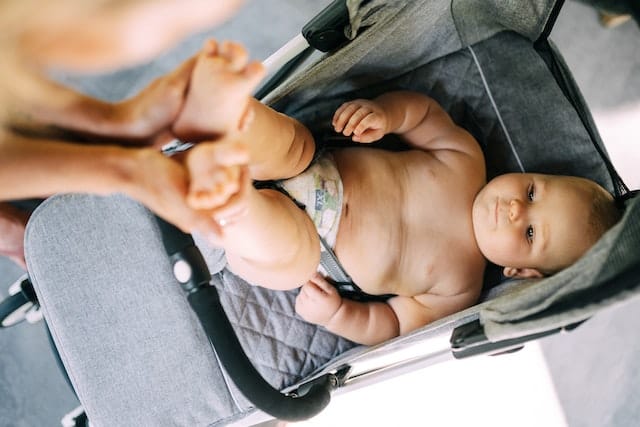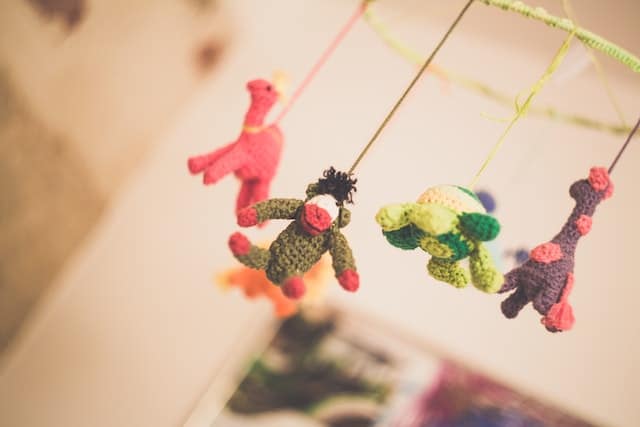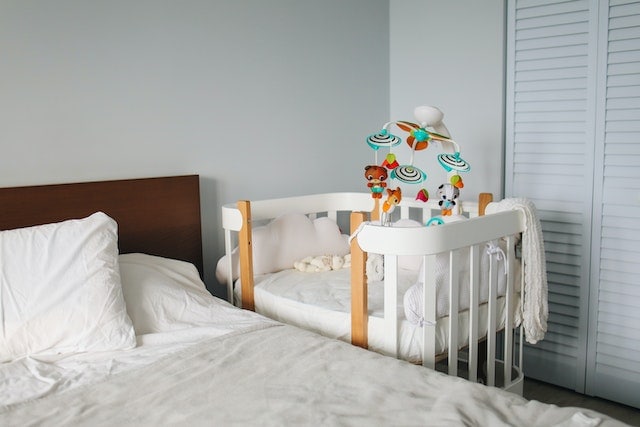Keeping a baby warm at night is essential for their comfort and safety. For many parents, swaddling is the go-to solution for keeping their little ones warm and cozy.
However, not all babies like to be swaddled, and some may even find it uncomfortable. So, what can parents do to keep their babies warm at night without swaddling?
Understanding Baby’s Body Temperature Before we dive into alternative solutions, it’s important to understand how a baby’s body temperature works.
Babies are not able to regulate their body temperature as efficiently as adults, which means they are more susceptible to temperature changes. Additionally, babies lose body heat faster than adults, which is why it’s important to keep them warm and cozy at all times.
Safe Sleep Guidelines for Babies The American Academy of Pediatrics recommends that babies sleep on their backs on a firm and flat surface to reduce the risk of Sudden Infant Death Syndrome (SIDS).
It’s also important to keep the baby’s sleep area free from any soft objects, loose bedding, or toys that could potentially suffocate them. With that in mind, let’s explore some alternative ways to keep your baby warm at night without swaddling.
Key Takeaways
- Understanding how a baby’s body temperature works is key to keeping them warm and comfortable at night.
- Following safe sleep guidelines for babies is crucial for their safety and wellbeing.
- Alternative ways to keep a baby warm at night without swaddling include dressing them in appropriate clothing, using sleep sacks, and monitoring the room temperature.
Understanding Baby’s Body Temperature
Babies have a unique circulatory system that helps regulate their body temperature. They have a higher metabolic rate than adults, which means they generate more heat.
However, they also lose heat more quickly due to their small size and thin layer of body fat. This makes it important to keep them warm, especially at night.
One way to check if a baby is cold is to feel their hands and feet. If they are cold, it may be a sign that the baby’s body temperature is dropping. However, it is important to note that babies often have cold hands and feet even when they are warm enough, as their circulatory system is still developing.
Another way to check if a baby is cold is to feel their neck. If it feels cold to the touch, it may be a sign that the baby is not warm enough. It is important to avoid overheating the baby as well, as this can increase the risk of Sudden Infant Death Syndrome (SIDS).
When dressing a baby for bed, it is important to choose appropriate clothing based on the room temperature. A good rule of thumb is to dress the baby in one more layer than what an adult would wear in the same temperature.
For example, if an adult is comfortable in a t-shirt and shorts, the baby should wear a onesie and a sleep sack.
In addition to clothing, there are other ways to keep a baby warm at night without swaddling. These include using a sleep sack or wearable blanket, placing a hot water bottle in the crib for a few minutes before bedtime, and keeping the room temperature between 68-72 degrees Fahrenheit.
Overall, understanding a baby’s body temperature and how to keep them warm at night is important for their health and well-being. By following these tips, parents can ensure that their baby is comfortable and safe while sleeping.
Safe Sleep Guidelines for Babies
When it comes to keeping babies warm at night, it’s important to follow safe sleep guidelines to reduce the risk of Sudden Infant Death Syndrome (SIDS).
The American Academy of Pediatrics (AAP) recommends the following guidelines for safe sleep:
- Always place babies on their back to sleep, for both naps and nighttime sleep.
- Use a firm and flat sleep surface, such as a crib or bassinet, with a tight-fitting sheet.
- Avoid soft bedding, including blankets, pillows, and bumper pads, as they can increase the risk of suffocation or SIDS.
- Keep the sleep area free of toys, stuffed animals, and other objects that could pose a choking hazard.
- Do not let babies sleep in an adult bed, couch, or armchair, as it can increase the risk of suffocation or SIDS.
- Share a room with the baby, but not the same sleeping surface, for at least the first six months of life, or ideally, for the first year.
By following these guidelines, parents can help ensure their baby’s safety while keeping them warm and comfortable at night.
Ideal Nursery Temperature
Maintaining an ideal nursery temperature is crucial for keeping babies warm and comfortable at night. The ideal temperature for a baby’s room is between 68-72°F (20-22°C).
It is recommended to use a thermometer to monitor the temperature and ensure it stays within this range.
During winter months or colder seasons, it may be tempting to turn up the heat to keep the baby warm. However, overheating can be dangerous and increase the risk of Sudden Infant Death Syndrome (SIDS).
It’s important to dress the baby appropriately for the room temperature and avoid using too many layers or blankets.
To help regulate the temperature, consider using a space heater or a humidifier. A space heater can provide additional warmth without overheating the room, while a humidifier can add moisture to the air and prevent dryness that can make the room feel colder.
In summary, maintaining an ideal nursery temperature is essential for keeping babies warm and comfortable at night. It is important to use a thermometer to monitor the temperature and dress the baby appropriately for the room temperature.
Using a space heater or humidifier can also help regulate the temperature and prevent overheating or dryness.
Baby Bedding Essentials
When it comes to keeping a baby warm at night without swaddling, it’s important to have the right bedding essentials.
Here are some key items to consider:
- Crib or Bassinet: A safe and secure sleeping environment is crucial for a baby. Whether you choose a crib or a bassinet, make sure it meets current safety standards and is free from any loose parts or sharp edges.
- Firm Mattress: A firm and flat mattress is recommended for babies to reduce the risk of suffocation or Sudden Infant Death Syndrome (SIDS). Avoid soft or cushioned mattresses, as they can increase the risk of suffocation.
- Cotton Fitted Sheet: A fitted sheet made from breathable cotton is the best choice for a baby’s bedding. It should fit snugly on the mattress and not come loose, as loose bedding can also pose a suffocation risk.
- Loose Bedding: It’s important to avoid any loose bedding in a baby’s sleep environment, including blankets, pillows, and stuffed animals. These items can increase the risk of suffocation or SIDS.
- Crib Bumpers: While crib bumpers were once a popular choice for many parents, they are no longer recommended due to the risk of suffocation and strangulation. It’s best to avoid them altogether.
- Bedding: When it comes to choosing bedding for a baby, less is more. Stick to a fitted sheet and a lightweight blanket, if needed, to keep them warm at night. Avoid heavy comforters or duvets, as these can pose a suffocation risk.
By choosing the right bedding essentials, parents can create a safe and comfortable sleep environment for their baby without the need for swaddling.
Blankets and Swaddles
When it comes to keeping babies warm at night, blankets and swaddles are some of the most popular options. While swaddling is not always necessary, blankets can provide an extra layer of warmth, especially during colder months.
Heavy blankets can be a great choice for keeping babies warm, but it is important to make sure that they are not too heavy or bulky. A wearable blanket or sleep sack can be a safer option, as they are designed to keep babies warm without the risk of suffocation.
One popular brand of wearable blankets is Halo, which offers a range of options for babies of different ages and sizes. These sleep sacks are designed to be snug and comfortable, while also providing the necessary warmth for a good night’s sleep.
When selecting blankets or sleep sacks, it is important to consider the material and thickness. Soft, breathable fabrics like cotton are often a good choice, as they can help regulate body temperature and prevent overheating.
Overall, blankets and swaddles can be a great way to keep babies warm and comfortable at night, but it is important to choose the right materials and avoid any potential safety hazards.
Also read: Is Nested Bean Safe
Dressing Baby for Bed
When it comes to keeping a baby warm at night without swaddle, dressing them appropriately is key.
Here are some tips on how to dress your baby for bed:
Choose the Right Pajamas
The right pajamas can make all the difference in keeping your baby warm at night. Look for pajamas made from warm, breathable fabrics like cotton or fleece.
Avoid materials that trap moisture, such as wool or synthetic blends. Make sure the pajamas fit snugly but are not too tight, as this can restrict movement and cause discomfort.
Layer Up
Layering is an effective way to keep your baby warm without swaddle. Start with a onesie or undershirt, then add a long-sleeved shirt or sweater, followed by pajama pants or leggings. If it’s particularly cold, you can also add a sleep sack or wearable blanket over the top.
Consider the Room Temperature
The ideal room temperature for a baby’s sleep environment is between 68 and 72 degrees Fahrenheit. If the room is particularly cold, you may need to add an extra layer of clothing or a heavier sleep sack.
If the room is warmer, opt for lighter pajamas or a lighter weight sleep sack.
Account for Rolling Over
If your baby is at the age where they are starting to roll over, make sure their clothing choices won’t impede their movement.
Choose pajamas that allow for easy movement and won’t bunch up or restrict their arms and legs. A wearable blanket or sleep sack can also be a good option, as it won’t get tangled up like blankets can.
By following these tips, you can help ensure your baby stays warm and comfortable throughout the night without the need for swaddle.
Additional Baby Warming Techniques
In addition to swaddling, there are several other techniques that can be used to keep a baby warm at night.
Here are some effective methods:
Hot Water Bottle
A hot water bottle can be a great way to keep a baby warm at night. Simply fill the bottle with hot water and place it in the baby’s bed before putting them down.
Make sure the bottle is covered with a cloth or towel to prevent burns. Be sure to remove the bottle before placing the baby in the bed.
Heating Pad
A heating pad can also be used to warm up a baby’s bed. Place the heating pad under the baby’s mattress or under a blanket for a few minutes before putting the baby down. Be sure to remove the heating pad before placing the baby in the bed.
Rug
A rug can help to insulate a cold floor and keep the baby’s bed warm. Place a rug under the baby’s bed to help keep them warm.
Draft
If there is a draft in the baby’s room, it can make the room feel colder than it actually is. Close any windows or doors that are causing the draft, and use draft stoppers to prevent cold air from coming in.
Windows
If the baby’s room has single-pane windows, it can be difficult to keep the room warm. Consider adding double-glazed windows to help insulate the room and keep it warm.
Cold Floor
If the baby’s room has a cold floor, it can make the room feel colder than it actually is. Consider adding a rug or carpet to help insulate the floor and keep the room warm.
Curtains
Thick curtains can help to insulate the baby’s room and keep it warm. Close the curtains at night to help keep the heat in.
Radiator
If the baby’s room has a radiator, make sure it is turned on and set to a comfortable temperature. Keep in mind that the radiator should be placed away from the baby’s bed to prevent burns.
By using these additional techniques, parents can keep their babies warm and comfortable at night without swaddling.
Monitoring Baby’s Comfort and Safety
It is important to monitor a baby’s comfort and safety throughout the night to ensure they are sleeping well and not at risk of any harm. Without the use of a swaddle, it is especially important to pay close attention to the baby’s temperature and movements.
One way to monitor a baby’s comfort is with a baby monitor. The Cubo AI Smart Baby Monitor is a great option as it offers HD night vision, a nightlight, and a two-way talk feature for added peace of mind.
The monitor can be used to check on the baby’s position and ensure they are not too hot or too cold.
Parents can also use their own senses to monitor their baby’s comfort. They can feel the baby’s skin to check for warmth or coolness, and observe their breathing and movements.
If the baby seems restless or uncomfortable, they may need to adjust their clothing or bedding.
It is important to ensure the baby’s sleeping environment is safe as well. The crib should be free of any loose blankets or pillows, and the baby should be placed on their back to reduce the risk of SIDS.
Parents can use a sleep sack or wearable blanket to keep the baby warm without the need for a swaddle.
Overall, monitoring a baby’s comfort and safety is crucial for a good night’s sleep. By using a baby monitor and paying close attention to the baby’s movements and environment, parents can ensure their little one is sleeping soundly and safely.
Feeding and Hydration
Keeping a baby warm at night is not only about blankets and clothing, but also about ensuring that they are well-fed and hydrated. A well-fed and hydrated baby will have better body temperature regulation and be more comfortable throughout the night.
Nursing mothers should ensure that they are drinking enough fluids to maintain their milk supply and keep their baby hydrated. It is recommended that nursing mothers drink at least 8-10 cups of fluids per day.
If the mother is not drinking enough fluids, it can affect the quality and quantity of breast milk, which can lead to dehydration in the baby.
Pediatricians recommend feeding babies on demand, which means feeding them whenever they show signs of hunger. This can help ensure that the baby is getting enough nutrients and fluids throughout the day and night.
For formula-fed babies, it is important to follow the instructions on the formula container and ensure that the baby is getting the appropriate amount of formula.
Breastfeeding can also help keep a baby warm at night. Breast milk is warm and can help regulate the baby’s body temperature. Additionally, breastfeeding releases hormones in both the mother and baby that can promote relaxation and sleep.
In addition to milk, parents can also offer water to their baby if they are over six months old. This can help keep the baby hydrated and comfortable throughout the night.
Overall, ensuring that a baby is well-fed and hydrated is an important aspect of keeping them warm and comfortable at night. Parents should consult with their pediatrician and follow their recommendations for feeding and hydration.
Learn more about swaddles: How Tight Should a Swaddle Be
Transitioning From Swaddling
As babies grow, they will eventually outgrow the need for swaddling. However, transitioning from swaddling can be a challenging process for both the baby and the parents.
Here are some tips to make the transition smoother:
One Arm Out
One way to transition from swaddling is to gradually allow one arm out of the swaddle. This can help the baby adjust to the feeling of having more freedom and movement.
It is important to note that the arm that is left inside the swaddle should still be snugly wrapped to provide a sense of security.
Startle Reflex
Babies have a startle reflex that can cause them to wake up suddenly. When transitioning from swaddling, it is important to keep this reflex in mind.
Parents can use a sleep sack or a wearable blanket to keep the baby warm while also preventing the startle reflex from waking them up.
Transition
It is important to remember that transitioning from swaddling is a gradual process. Parents should not expect their baby to adjust immediately. It may take a few nights for the baby to get used to the new sleeping arrangement.
It is also important to monitor the baby closely during this transition period to ensure they are comfortable and safe.
Overall, transitioning from swaddling can be a challenging process, but with patience and consistency, it can be done successfully.
Additional Considerations
When it comes to keeping a baby warm at night without swaddling, there are a few additional considerations to keep in mind. Here are some tips to ensure that your little one stays cozy and safe throughout the night.
Follow Official Guidelines
It’s important to follow official guidelines when it comes to keeping your baby warm at night. The American Academy of Pediatrics recommends keeping the room at a temperature between 68 and 72 degrees Fahrenheit.
Additionally, they advise against using loose bedding, soft toys, or other objects in the crib, as they can pose a suffocation hazard.
Choose the Right Bedding
When choosing bedding for your baby, it’s important to consider factors such as thickness and material.
A duvet or heavy blanket may seem like a good option for keeping your baby warm, but it can actually be too heavy and increase the risk of overheating. Instead, opt for lightweight blankets made of breathable materials such as cotton or muslin.
Keep the Room Secure
To ensure that your baby stays warm throughout the night, it’s important to keep the room secure. Check for drafts and make sure that windows and doors are properly sealed.
You may also want to consider using a mobile or white noise machine to create a soothing environment that promotes restful sleep.
Monitor Energy Usage
While it’s important to keep your baby warm at night, it’s also important to be mindful of energy usage. Consider using a programmable thermostat to regulate the temperature in the room and save energy.
You may also want to invest in a sleep sack or wearable blanket, which can help regulate your baby’s body temperature without the need for additional heating.
Prioritize a Good Night’s Rest
Ultimately, the most important consideration when it comes to keeping your baby warm at night is ensuring that they get a good night’s rest.
By following official guidelines, choosing the right bedding, and creating a secure and comfortable environment, you can help your little one sleep soundly and wake up feeling refreshed.
Related Posts:
Frequently Asked Questions
What should my baby wear to sleep without a swaddle?
When it comes to dressing a baby for sleep without a swaddle, it’s important to consider the temperature of the room. A good rule of thumb is to dress the baby in one more layer than an adult would wear to sleep comfortably in the same room.
For example, if an adult would sleep in a t-shirt and shorts, the baby could wear a onesie, footed pajamas, and a sleep sack.
How can I keep my baby warm at night without a sleeping bag?
There are several ways to keep a baby warm at night without a sleeping bag. You can dress the baby in warm layers, use a warm blanket, or use a sleep sack. If you choose to use a blanket, make sure it is a lightweight, breathable material and that it is tucked securely around the baby’s body.
When should I stop covering my baby’s hands at night?
Once a baby is able to roll over, it’s generally safe to stop covering their hands at night. This is because they are able to move their hands and arms freely and can push away any blankets or coverings that may be obstructing their breathing.
Why are my baby’s hands cold at night in a sleep sack?
It’s normal for a baby’s hands and feet to feel cooler than the rest of their body, as their circulation is still developing. However, if the baby’s hands feel excessively cold, it may be a sign that they are not warm enough. Consider dressing the baby in warmer layers or using a thicker sleep sack.
What are some alternatives to swaddling for keeping my baby warm at night?
Some alternatives to swaddling for keeping a baby warm at night include using a sleep sack, dressing the baby in warm layers, and using a warm blanket. It’s important to choose a method that is safe and comfortable for the baby.
How do I know if my baby is warm enough at night without a swaddle?
One way to check if a baby is warm enough at night is to feel their chest or back. If it feels warm to the touch, they are likely warm enough. It’s also important to monitor the baby’s behavior and look for signs of discomfort or distress, such as fussiness or restlessness.

Iesha is a loving mother of 2 beautiful children. She’s an active parent who enjoys indoor and outdoor adventures with her family. Her mission is to share practical and realistic parenting advice to help the parenting community becoming stronger.




